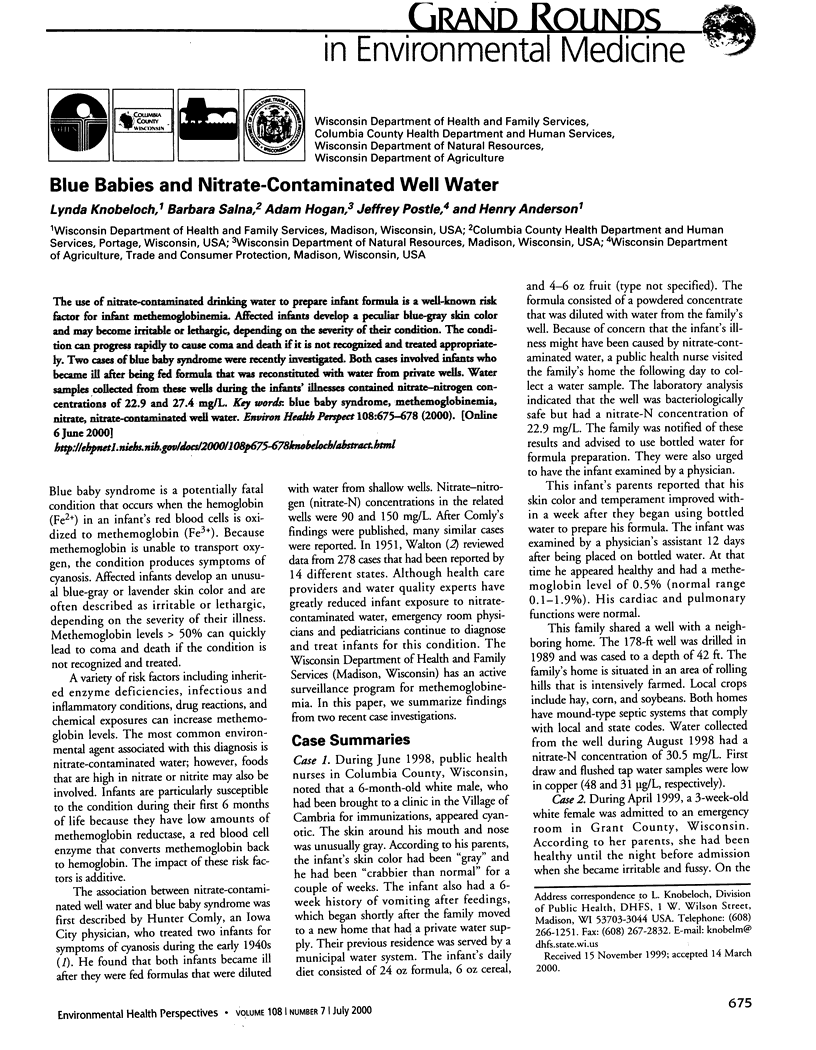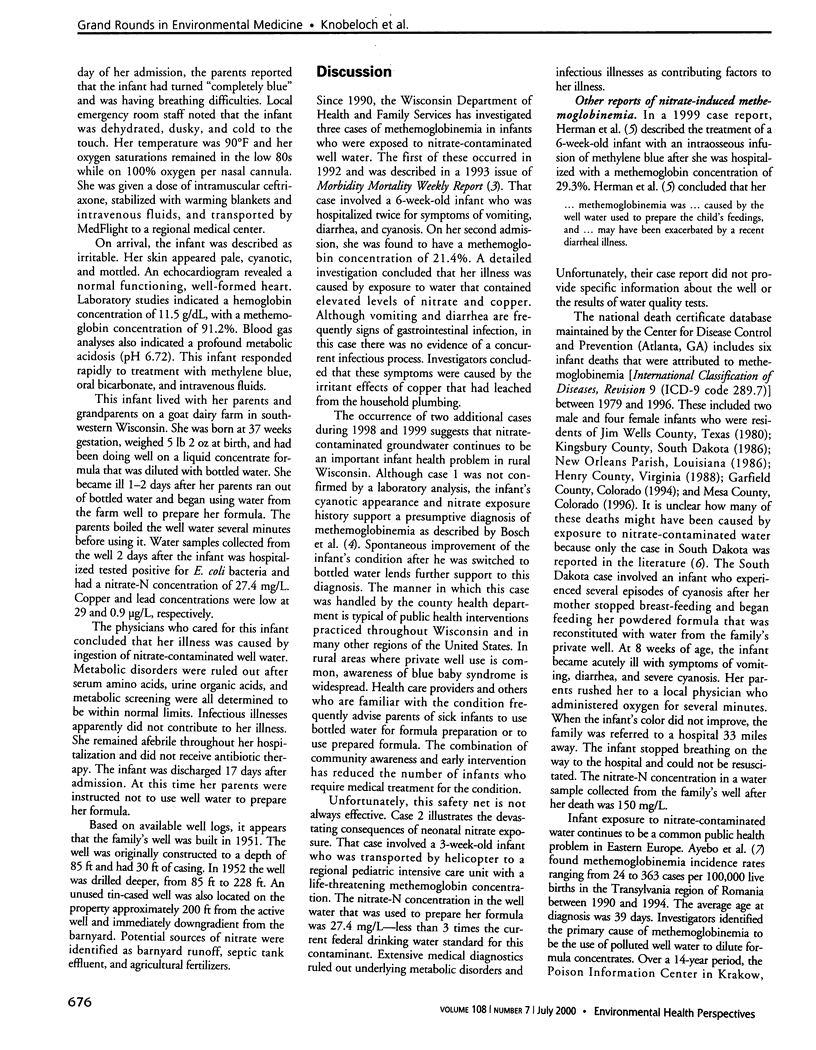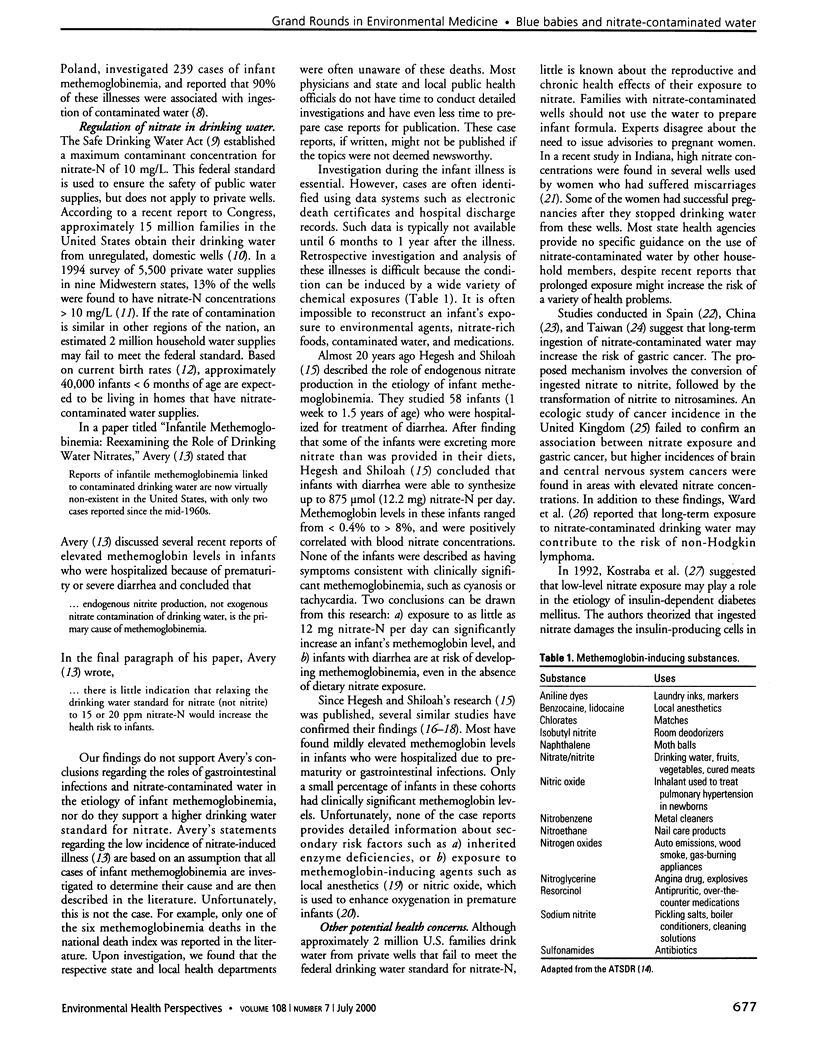Abstract
The use of nitrate-contaminated drinking water to prepare infant formula is a well-known risk factor for infant methemoglobinemia. Affected infants develop a peculiar blue-gray skin color and may become irritable or lethargic, depending on the severity of their condition. The condition can progress rapidly to cause coma and death if it is not recognized and treated appropriately. Two cases of blue baby syndrome were recently investigated. Both cases involved infants who became ill after being fed formula that was reconstituted with water from private wells. Water samples collected from these wells during the infants' illnesses contained nitrate-nitrogen concentrations of 22.9 and 27.4 mg/L.
Full text
PDF



Selected References
These references are in PubMed. This may not be the complete list of references from this article.
- Avery A. A. Infantile methemoglobinemia: reexamining the role of drinking water nitrates. Environ Health Perspect. 1999 Jul;107(7):583–586. doi: 10.1289/ehp.99107583. [DOI] [PMC free article] [PubMed] [Google Scholar]
- Ayebo A, Kross BC, Vlad M, Sinca A. Infant Methemoglobinemia in the Transylvania Region of Romania. Int J Occup Environ Health. 1997 Jan;3(1):20–29. doi: 10.1179/oeh.1997.3.1.20. [DOI] [PubMed] [Google Scholar]
- Barrett J. H., Parslow R. C., McKinney P. A., Law G. R., Forman D. Nitrate in drinking water and the incidence of gastric, esophageal, and brain cancer in Yorkshire, England. Cancer Causes Control. 1998 Mar;9(2):153–159. doi: 10.1023/a:1008878126535. [DOI] [PubMed] [Google Scholar]
- Davidson D., Barefield E. S., Kattwinkel J., Dudell G., Damask M., Straube R., Rhines J., Chang C. T. Inhaled nitric oxide for the early treatment of persistent pulmonary hypertension of the term newborn: a randomized, double-masked, placebo-controlled, dose-response, multicenter study. The I-NO/PPHN Study Group. Pediatrics. 1998 Mar;101(3 Pt 1):325–334. doi: 10.1542/peds.101.3.325. [DOI] [PubMed] [Google Scholar]
- Hanukoglu A., Danon P. N. Endogenous methemoglobinemia associated with diarrheal disease in infancy. J Pediatr Gastroenterol Nutr. 1996 Jul;23(1):1–7. doi: 10.1097/00005176-199607000-00001. [DOI] [PubMed] [Google Scholar]
- Hegesh E., Shiloah J. Blood nitrates and infantile methemoglobinemia. Clin Chim Acta. 1982 Oct 27;125(2):107–115. doi: 10.1016/0009-8981(82)90187-5. [DOI] [PubMed] [Google Scholar]
- Herman M. I., Chyka P. A., Butler A. Y., Rieger S. E. Methylene blue by intraosseous infusion for methemoglobinemia. Ann Emerg Med. 1999 Jan;33(1):111–113. doi: 10.1016/s0196-0644(99)70427-0. [DOI] [PubMed] [Google Scholar]
- Hjelt K., Lund J. T., Scherling B., Bendixen S., Lundstrøm K., Støvring S., Voldsgaard P., Linnet K. Methaemoglobinaemia among neonates in a neonatal intensive care unit. Acta Paediatr. 1995 Apr;84(4):365–370. doi: 10.1111/j.1651-2227.1995.tb13650.x. [DOI] [PubMed] [Google Scholar]
- Kostraba J. N., Gay E. C., Rewers M., Hamman R. F. Nitrate levels in community drinking waters and risk of IDDM. An ecological analysis. Diabetes Care. 1992 Nov;15(11):1505–1508. doi: 10.2337/diacare.15.11.1505. [DOI] [PubMed] [Google Scholar]
- Krafte-Jacobs B., Brilli R., Szabó C., Denenberg A., Moore L., Salzman A. L. Circulating methemoglobin and nitrite/nitrate concentrations as indicators of nitric oxide overproduction in critically ill children with septic shock. Crit Care Med. 1997 Sep;25(9):1588–1593. doi: 10.1097/00003246-199709000-00030. [DOI] [PubMed] [Google Scholar]
- Lutyński R., Steczek-Wojdyła M., Wojdyła Z., Kroch S. The concentrations of nitrates and nitrites in food products and environment and the occurrence of acute toxic methemoglobinemias. Przegl Lek. 1996;53(4):351–355. [PubMed] [Google Scholar]
- Morales-Suárez-Varela M. M., Llopis-Gonzalez A., Tejerizo-Perez M. L. Impact of nitrates in drinking water on cancer mortality in Valencia, Spain. Eur J Epidemiol. 1995 Feb;11(1):15–21. doi: 10.1007/BF01719941. [DOI] [PubMed] [Google Scholar]
- Parslow R. C., McKinney P. A., Law G. R., Staines A., Williams R., Bodansky H. J. Incidence of childhood diabetes mellitus in Yorkshire, northern England, is associated with nitrate in drinking water: an ecological analysis. Diabetologia. 1997 May;40(5):550–556. doi: 10.1007/s001250050714. [DOI] [PubMed] [Google Scholar]
- Virtanen S. M., Jaakkola L., Räsänen L., Ylönen K., Aro A., Lounamaa R., Akerblom H. K., Tuomilehto J. Nitrate and nitrite intake and the risk for type 1 diabetes in Finnish children. Childhood Diabetes in Finland Study Group. Diabet Med. 1994 Aug-Sep;11(7):656–662. doi: 10.1111/j.1464-5491.1994.tb00328.x. [DOI] [PubMed] [Google Scholar]
- Ward M. H., Mark S. D., Cantor K. P., Weisenburger D. D., Correa-Villaseñor A., Zahm S. H. Drinking water nitrate and the risk of non-Hodgkin's lymphoma. Epidemiology. 1996 Sep;7(5):465–471. [PubMed] [Google Scholar]
- Wilburn-Goo D., Lloyd L. M. When patients become cyanotic: acquired methemoglobinemia. J Am Dent Assoc. 1999 Jun;130(6):826–831. doi: 10.14219/jada.archive.1999.0306. [DOI] [PubMed] [Google Scholar]
- Xu G., Song P., Reed P. I. The relationship between gastric mucosal changes and nitrate intake via drinking water in a high-risk population for gastric cancer in Moping county, China. Eur J Cancer Prev. 1992 Oct;1(6):437–443. doi: 10.1097/00008469-199210000-00007. [DOI] [PubMed] [Google Scholar]
- Yang C. Y., Cheng M. F., Tsai S. S., Hsieh Y. L. Calcium, magnesium, and nitrate in drinking water and gastric cancer mortality. Jpn J Cancer Res. 1998 Feb;89(2):124–130. doi: 10.1111/j.1349-7006.1998.tb00539.x. [DOI] [PMC free article] [PubMed] [Google Scholar]
- van Maanen J. M., van Dijk A., Mulder K., de Baets M. H., Menheere P. C., van der Heide D., Mertens P. L., Kleinjans J. C. Consumption of drinking water with high nitrate levels causes hypertrophy of the thyroid. Toxicol Lett. 1994 Jun;72(1-3):365–374. doi: 10.1016/0378-4274(94)90050-7. [DOI] [PubMed] [Google Scholar]


